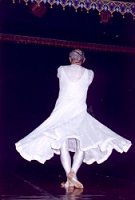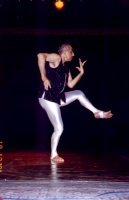
|  |

|  |
Q & A: Audience Artist Interface 21st Natyakala Conference - 2001 Chennai, India DEC 20, 2001 Astad Deboo (Mumbai) "Choreography workshops for special needs" Feb 2002 Astad Deboo spoke extempore about his choreography workshops with the deaf in India and abroad. He showed excerpts from the documentary "The Dancing Dolphins" where he leads the Calcutta based group The Action Players. The post lecture session threw up some very interesting audience speaker interaction.   Nicholas Rowe of Dance Europe: Thank you, Astad, I really enjoyed the performance. It was very touching. I am a great admirer of your work. Concerning the work you do, I do have a major concern, the piece of music, and first of all, it is the students. I think we, as an audience are privy to their private world, especially those who are profoundly deaf and that sort of disturbed me. In a way, we are imposing an aesthetic upon them based on a sense of our own value, building and suggesting their thought, so maybe they feel what they have contributed as dancers is not much and that they are only a poor cousin to those who speak. Also, they are not able to know the choral music that the audience can hear. Astad: The reason I chose the music is that they pick up the vibrations, which they have internalized in a way. There are parts of the work, which was done in silence. I only showed you some excerpts, which had music. For me it was a challenge, I had to push them so they counted on the right beat. For them it was to be on the beat, to count, to synchronize. That was my purpose of using the music for them. I am not trying in any way to make them look like poor cousins. It was just a way of starting a work with them. In the program there were lots of pieces, which were done in silence which the audience took into their journey, so it's very much in the program which I haven't shown you now due to lack of time. Nicholas Rowe: I like the idea for the audience to experience like deaf people do and gain an insight into their world. Maybe another way of getting the people together is to put in a small visual which will be another way of illuminating the audience. Astad: Sure, that is very much possible. This was the first time that I started working with them and it went on. The next one I'm planning is very much on the lines that you mentioned. Ashish Khokar: What qualitative difference does the whole process of learning and doing dance make to their day-to-day lives? Astad: They are more confident. The veteran performers have become divas too. Especially when they all came back from the US, they felt like the cats whiskers and that has sort of given them confidence. They are acting, the way they project themselves, they have become aware of how to interact, how to deal with fame. From what I hear from Zareen who works with them, it has helped them a lot. They as performers have gone to schools to do workshops for senior students. Sangeeta Isvaran: How has working with the deaf changed your dance? Astad: I haven't really changed my dance. My own personal work is minimal even when I am collaborating with other forms - like I am working now with the tang ta martial artists from Imphal, Manipur. When I initially started working with the deaf, they were full of dislike because I was a strict disciplinarian. I was really pushing them and they hated it. I told them 'I don't want this happening when you are on stage, that you can make mistakes and expect me to go along with that. I do not want that and neither do you'. I work with them exactly the same as if I were working with people who can hear. There's no sort of concession given to them. In the documentary that I have shown you, where I am giving them the cues, I look like some sort of awful taskmaster. They got used to it after a while. At times, when they still can't get it even after I have told them 10 times, they can sort of feel it when I go in front of them and exercise my frustration. It was very frustrating for them too. It was a learning exercise and I had to tell myself, "It's OK, you are dealing with them, there's a problem here. So you take two steps back". (From this point, the discussion slants towards his performance the earlier evening at the Krishna Gana Sabha) Q: In your performance last evening, I saw shades of Pina Bausch and then there was this mesmerizing continuous movement that never stopped, it was a continuous flow. Where was the language that is your own? There were glimpses of it here and there, that's it. Where does your language come from? Astad: My dance education has been in Kathak and Kathakali and after that, my learning experiences of modern dance techniques and spending time with various dance companies, not only in the West but in Asia as well, in Japan and Indonesia. I've picked up body language, which I felt I could easily assimilate into what I had started to evolve. The evolution and learning process still continues. If you were to see my program again, you will see so many different nuances to it. In about 50% of the work, improvisation is going on. Q: To continue a language is so repetitive. But there is no repetition in what you are doing. So where does your language come from? Is it Japan? Any influence of Butoh at all in your work? Astad: A bit. It's just a body language, which I have been evolving and it's become my signature. My language comes from our traditions or something that I've seen or things that are stewing in my mind and I've just sort of decided, let me try this. Then again, the body is not what it used to be. I try to figure out what my body is now able to sustain and with constant looking, it comes about. I won't say it's this particular source or that. Ashish Khokar: Astad is too modest! Astad: There is still a lot of frustration working in the environment that I work in. Unfortunately, in a city like Mumbai, I'm really dead there. It's amazing that in a city of 12 million people, the environment does not allow somebody to create, to sustain, because the whole support system really goes into fashion and films. I do enjoy looking at Bollywood dances and some of the choreography. The choreographers do a wonderful job, but I am still at a loss to understand why there's still no umbrella, no support even from young entrepreneurs. When you go to them, I am really sorry to say that the MTV culture has taken them over. So a person like me is still striving to survive and I say, no matter what, I'll continue as a dancer. I'm like a jack in the box. I'll always pop up, nothing can keep me down. Q & A: Audience Artist Interface 21st Natyakala Conference - 2001 |